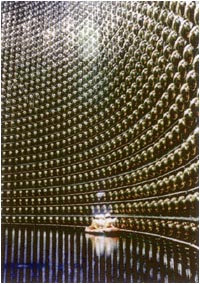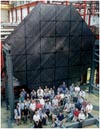 | 
MINOS Collaboration
|
1998
The neutrino detector for the Super-Kamiokande experiment in Japan contains ultrapure water surrounded by an array of thousands of photo-tubes, arranged to catch the flashes of light from neutrino interactions in the water. In 1998, researchers at "Super-K" found evidence for a small mass for neutrinos coming to earth from particle interactions in cosmic rays. If neutrinos, until recently thought to be massless, actually do have a mass, the implications will be profound, not only for particle physics but for astronomy and cosmology.
At right is the MINOS collaboration at the Department of Energy’s Fermilab, before a slice of the 10,000-ton detector they will build to capture neutrino interactions. The MINOS experiment will use beams of accelerator-produced neutrinos by Fermilab's Tevatron to investigate neutrino mass.
|


